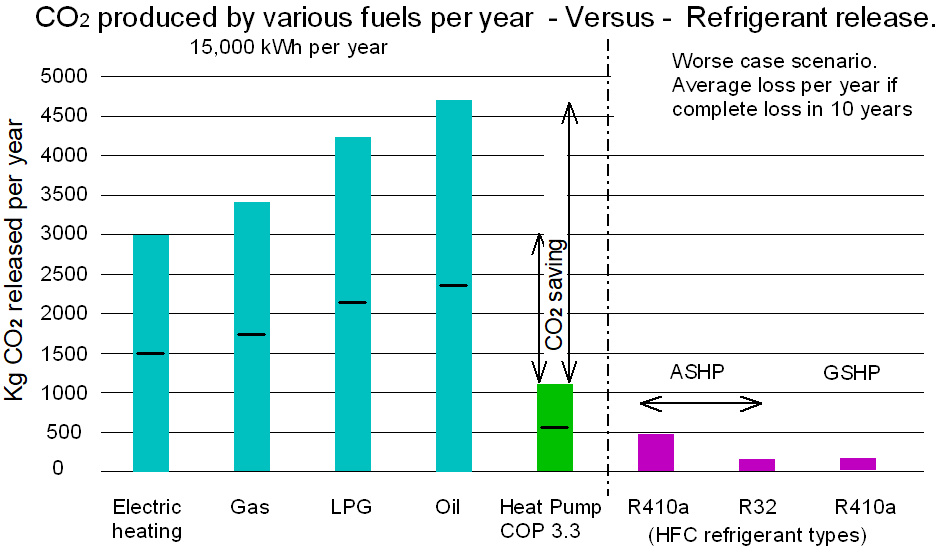REFRIGERANTS (the working fluid inside the heat pump)
( See my 12 minute YouTube video on refrigerants )
Every normal heat pump and fridge uses a fluid to enable the heat transfer. This pressurised fluid evaporates and condenses in different heat-exchangers in the unit, and there are a limited number of suitable fluids that will work efficiently and safely.
(NB this is different to any glycol antifreeze solution used in the other parts of the system)
Gone are the days of refrigerants that affected the ozone layer. They are now all ‘ozone-friendly’. However, most refrigerants (F-gasses) do have a high global warming potential, meaning that they are far more potent for warming the planet than the gas – carbon dioxide. That said, the quantities of these fluids used in heat pumps is extremely small.
Unlike older equipment (and car air-conditioning), the refrigerant within a modern heat pump unit is very unlikely to leak at all (when did you last hear of a refrigerator leaking its refrigerant?) but should it do so, this would detract from the net CO2 savings made when the heat pump is heating.
The following information attempts to give a balanced view of the issue and concludes that the CO2 savings made during the heat pump’s working life outweigh considerably any negative effects caused by the possible escape of refrigerant.
That said, it is far from ideal having many thousands of tons of refrigerant out there sealed into equipment, though it should be noted that the F-gas regulations make it illegal to release them into the atmosphere, and when equipment is scrapped, the refrigerant should be recovered and re-cycled or destroyed.
The following table lists the Global Warming Potential (GWP) of various refrigerants. This gives a figure of how damaging the gas is, as compared to an equivalent quantity of CO2. As an example, 1kG of R134a has the same Global Warming effect as 1430kG of CO2.
R32 is a relatively new refrigerant, and around 1/2 to 1/3rd as polluting as other commonly-used HFC refrigerants

Inside a typical 8kW air source heat pump there is usually about 2 to 2.5kg of refrigerant, and this refrigerant will not wear out. It should stay contained within the unit for its whole life, and recovered when the unit is scrapped. Ground source have more compact heat-exchangers, so the charge quantity is likely to be considerably lower, typically 0.85kg for new similar-size unit. However this could vary considerably.
In the past, refrigeration equipment was notoriously leaky. However, modern package equipment should be all-welded construction, and a quality heat pump should never leak. However, though very rare, pipe fractures could happen and leakage could result from the unlikely need for a component change. From my experience, I would suggest that 1 complete loss of the charge in 10 years would be an unlucky worse-case scenario, and on average, the refrigerant loss would be far lower. In my comparison below, I have assumed this worst case scenario.
To make the quantities understandable, I have given the CO2 expected to be released when using various heating methods over a year. I have assumed a typical house using 15,000kWh of heat. Alongside (to the right) this I have given the CO2 equivalent if the refrigerant charge is released. My worse-case assumption here relates to the average leak per year if all were lost over 10 Years. Many heat pumps lose no refrigerant at all.
That said, I may be optimistic thinking that end-of-life heat pumps will be dealt with properly. Possibly far too many are scrapped irresponsibly.
Note, any system with a refrigerant pipe run (e.g. air-air split or hydro-box ASHP) is slightly more likely to leak.

Assumptions
I have used a fairy optimistic value of 0.2kgCO2/kWh for electricity, however the general future trend is a downward drop.
| CO2/kWh | Efficiency | CO2/kWh Net | |
| Electricity | 0.20 | 100% | 0.20 |
| Gas | 0.198 | 87% | 0.228 |
| LPG | 0.245 | 87% | 0.282 |
| Oil | 0.274 | 87% | 0.315 |
Highly-insulated house will use less energy, so the heat pump’s potential to save CO2 would also be lower, but even if we halve the blue columns on the graph, it shows that the commonly-used HFC refrigerants seem acceptable since the potential harm is relatively lower.
It is obviously preferable to use a much more benign alternative e.g. Hydrocarbon (HC) refrigerant. Such refrigerants would be too small to show up on this graph. Refrigerant R290 has been used for many applications, but flammability concerns have limited its use Here is an example of the general trend to use of hydrocarbon refrigerants.
The use of Carbon Dioxide as the refrigerant (transcritical) is a fairly recent development. However, care should be taken when selecting such units to ensure that they will be energy-efficient for the application in question.
Air source manufacturers are currently choosing different paths. Some are remaining down the R32 HFC route. Many are going down the R290 hydrocarbon route. My personal choice errs towards the Hydrocarbon since they are very energy-efficient and environmentally benign. The down-side is the flammability, so they are not suitable for every application and precautions need to be taken.
Back to the non-flammable HFC refrigerants that will no doubt be used for a long time to come. There should be scope for minimising leakage in many ways. e.g. pensioning off the old Flare connections as used on ‘Split’ system in favour of pipe coupling methods that are more reliable.